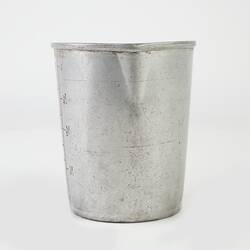Summary
Measuring jug with inverted text either brought out from England or acquired in Australia. It may have been one of a number of cooking items brought to Australia by Lucy Hathaway when she migrated from England in 1951. Otherwise it was obtained in Ballarat soon after settling in. Lucy was a keen baker and cook and won many prizes in the Ballarat Show for her mince pies and Christmas puddings. Her traditional Christmas dinners were elaborate affairs as the family settled and became more affluent and even in her later years her enormous turkeys contained two types of stuffing and she continued to make her dark, rich Christmas puddings.
Stanley and Lucy (nee Simmons) Hathaway and their daughter Hazel survived World War II in heavily bombed Coventry, England, remaining there until 1946. They attended the Victory in Europe celebrations there on 8 May 1945. The Hathaways relocated to Buckinghamshire (where second daughter Merle was born in 1948) and Hampshire between 1946 and 1951, finally deciding to migrate to Australia. They applied successfully to the Assisted Passage Migration Scheme but had to wait two years before departing, living and touring England in a caravan until departing on the 'New Australia' 17 November, 1951. They first stayed at the Bathurst Migrant Camp in New South Wales before being relocated to a housing commission estate in Ballarat, Victoria. Within six months they had purchased a block of land in Wendouree, living in a caravan while their house was built. The family became active members of the local Ballarat community, with Lucy working for the newly established McCallum House Centre for Retarded Children at Sebastopol and continued her strong interest in the Brownies and Girl Guides associations. They later relocated to Melbourne and then retired to Buninyong.
Physical Description
Silver tin measuring jug with handle attached at side with two small bolts. The jug has an indented pouring lip and one side has a series of pints and ounces measures. The measures are stamped on the inside of the jug to assist in measuring levels so appear inverted when viewed from the outside of the jug.
Significance
This collection represents the experiences of thousands of post-war assisted migrants from England who brought with them memories of danger, sadness, courage, austerity and celebration in both tangible and intangible forms. This family survived one of the most severe bombings of any English city during World War II and brought with them material symbols of endurance and triumph in the Victory Day dress and Union Jack flag, symbols with almost universal resonance. The collection also includes items which tell stories about the goods migrants select in order to start new lives and the continued use of those items in Australia, the adventure of the ship voyage, and the seeking of familiar interests in a new community. This particularly relates to the family's ongoing participation in the Girl Guides. The collection also explores the theme of maintaining connections and loyalties to homeland, in this case through memorabilia relating to the British monarchy and exchange projects with former local communities.
More Information
-
Collecting Areas
-
Acquisition Information
Donation from Merle Hathaway, 23 Jan 2013
-
Date Manufactured
-
Past Owner & User
Mrs Lucy J. Hathaway, Wendouree, Victoria, Australia, 1950s-1990s
-
Inscriptions
Stamped on inside of jug: 'PINTS'/ 'OUNCES'.
-
Classification
Migration, Settlement - first home & family, Tools & equipment
-
Category
-
Discipline
-
Type of item
-
Overall Dimensions
150 mm (Width), 110 mm (Height)
-
Keywords
British Immigration, Brought Goods, Migration & Settlement, World War II, 1939-1945, Shipboard Travel, Immigrant Voyages, Food Preparation, Cakes, Domestic Life, Domestic Equipment








